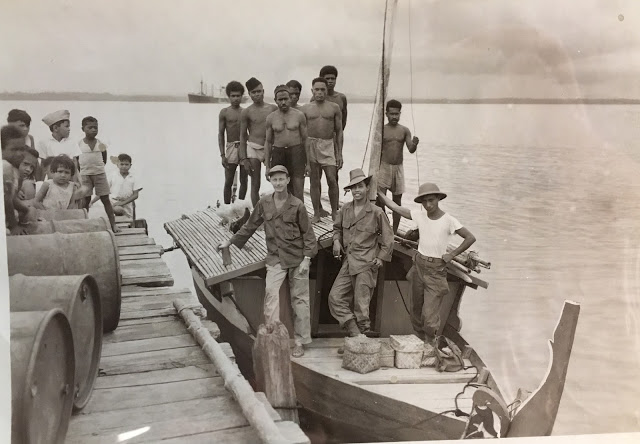Robert T. Smith’s search for World War II servicemen lost in the South Pacific
By Jerome Thompson

Sgt. Robert T. “Smitty” Smith (center) aboard a vessel in New Guinea. Photo courtesy of the Smithsonian Institution National Anthropological Archives MS2014-06
“Airplanes fall up not down is the opinion of American Graves Registration Service and Recovery personnel now operating in the New Guinea area. Teams of volunteer personnel are based at Fineshhafen, New Guinea, where the temporary National Cemetery for the Southwest Pacific is located. This work is the attempt to investigate all isolated air crashes and infantry burials where there is sufficient leads to warrant a search,” wrote U.S. Army Sgt. Robert T. “Smitty” Smith.
Smith, a native of Des Moines, spent World War II and years following up to the Korean War in the Graves Registration branch of the U.S. Army Quartermaster Corps. His duty took him from the 113th Cavalry’s Red Horse Armory in Des Moines in 1941, to the South Pacific from 1943 until 1949. He spent his service searching for the remains of downed airmen and ground troops killed in action or declared missing. His discoveries, while often fragmentary, could provide closure to the families of U.S. servicemen lost in the war. His story is found in the archives at the Iowa Gold Star Military Museum and in the Smithsonian Institution’s Archives of Anthropology. Smith left three years of journals, letters, papers and ephemera that document his time working in the jungles of New Guinea and the Solomon Islands.
Since the Civil War, the care of deceased military personnel and the maintenance of National Cemeteries were among the duties assigned to the Quartermaster General. Sixteen million Americans served in World War II and more than 400,000 died according to the Defense POW/MIA Accounting Agency. At the end of World War II, there were 79,000 Americans unaccounted for. This included those buried as unknowns, buried at sea, lost at sea, or missing in action.
Following World War II, the U.S. initiated “The Return of the World War II Dead Program.” The program was created to locate crash sites, re-examine battlefields for isolated graves and disinter temporary military cemeteries around the world. The U.S. Army created the American Graves Registration Service to take up this task. Smith could have gone home after the war, but he extended his service with the Graves Registration Service to comb the jungles in New Guinea.
TO READ THE ENTIRE STORY AND OTHER FASCINATING STORIES ABOUT IOWA HISTORY, subscribe to Iowa History Journal. You can also purchase back issues at the store.
